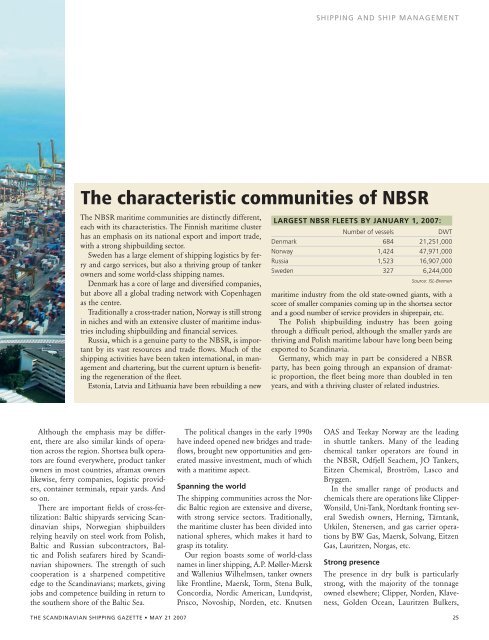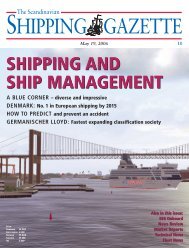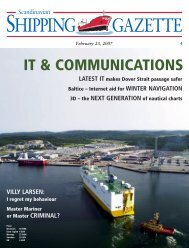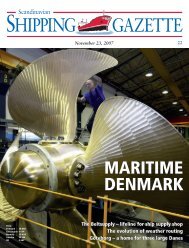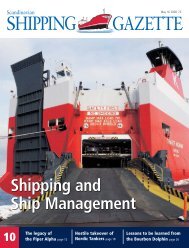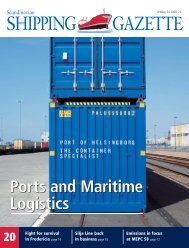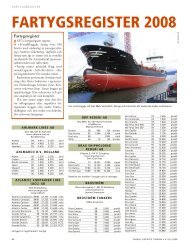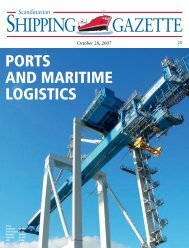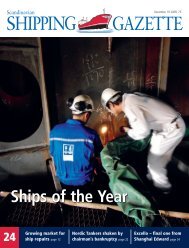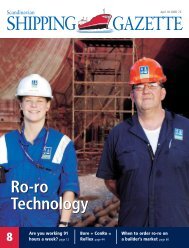SSG No 10 - Shipgaz
SSG No 10 - Shipgaz
SSG No 10 - Shipgaz
You also want an ePaper? Increase the reach of your titles
YUMPU automatically turns print PDFs into web optimized ePapers that Google loves.
The NBSR maritime communities are distinctly different,<br />
each with its characteristics. The Finnish maritime cluster<br />
has an emphasis on its national export and import trade,<br />
with a strong shipbuilding sector.<br />
Sweden has a large element of shipping logistics by ferry<br />
and cargo services, but also a thriving group of tanker<br />
owners and some world-class shipping names.<br />
Denmark has a core of large and diversified companies,<br />
but above all a global trading network with Copenhagen<br />
as the centre.<br />
Traditionally a cross-trader nation, <strong>No</strong>rway is still strong<br />
in niches and with an extensive cluster of maritime industries<br />
including shipbuilding and financial services.<br />
Russia, which is a genuine party to the NBSR, is important<br />
by its vast resources and trade flows. Much of the<br />
shipping activities have been taken international, in management<br />
and chartering, but the current upturn is benefiting<br />
the regeneration of the fleet.<br />
Estonia, Latvia and Lithuania have been rebuilding a new<br />
Although the emphasis may be different,<br />
there are also similar kinds of operation<br />
across the region. Shortsea bulk operators<br />
are found everywhere, product tanker<br />
owners in most countries, aframax owners<br />
likewise, ferry companies, logistic providers,<br />
container terminals, repair yards. And<br />
so on.<br />
There are important fields of cross-fertilization:<br />
Baltic shipyards servicing Scandinavian<br />
ships, <strong>No</strong>rwegian shipbuilders<br />
relying heavily on steel work from Polish,<br />
Baltic and Russian subcontractors, Baltic<br />
and Polish seafarers hired by Scandinavian<br />
shipowners. The strength of such<br />
cooperation is a sharpened competitive<br />
edge to the Scandinavians; markets, giving<br />
jobs and competence building in return to<br />
the southern shore of the Baltic Sea.<br />
The political changes in the early 1990s<br />
have indeed opened new bridges and tradeflows,<br />
brought new opportunities and generated<br />
massive investment, much of which<br />
with a maritime aspect.<br />
Spanning the world<br />
The shipping communities across the <strong>No</strong>rdic<br />
Baltic region are extensive and diverse,<br />
with strong service sectors. Traditionally,<br />
the maritime cluster has been divided into<br />
national spheres, which makes it hard to<br />
grasp its totality.<br />
Our region boasts some of world-class<br />
names in liner shipping, A.P. Møller-Mærsk<br />
and Wallenius Wilhelmsen, tanker owners<br />
like Frontline, Maersk, Torm, Stena Bulk,<br />
Concordia, <strong>No</strong>rdic American, Lundqvist,<br />
Prisco, <strong>No</strong>voship, <strong>No</strong>rden, etc. Knutsen<br />
SHIPPING AND SHIP MANAGEMENT<br />
The characteristic communities of NBSR<br />
LArgeSt nBSr fLeetS By JAnuAry 1, 2007:<br />
Number of vessels DWT<br />
Denmark 684 21,251,000<br />
<strong>No</strong>rway 1,424 47,971,000<br />
Russia 1,523 16,907,000<br />
Sweden 327 6,244,000<br />
Source: ISL-Bremen<br />
maritime industry from the old state-owned giants, with a<br />
score of smaller companies coming up in the shortsea sector<br />
and a good number of service providers in shiprepair, etc.<br />
The Polish shipbuilding industry has been going<br />
through a difficult period, although the smaller yards are<br />
thriving and Polish maritime labour have long been being<br />
exported to Scandinavia.<br />
Germany, which may in part be considered a NBSR<br />
party, has been going through an expansion of dramatic<br />
proportion, the fleet being more than doubled in ten<br />
years, and with a thriving cluster of related industries.<br />
OAS and Teekay <strong>No</strong>rway are the leading<br />
in shuttle tankers. Many of the leading<br />
chemical tanker operators are found in<br />
the NBSR, Odfjell Seachem, JO Tankers,<br />
Eitzen Chemical, Broström, Lasco and<br />
Bryggen.<br />
In the smaller range of products and<br />
chemicals there are operations like Clipper-<br />
Wonsild, Uni-Tank, <strong>No</strong>rdtank fronting several<br />
Swedish owners, Herning, Tärntank,<br />
Utkilen, Stenersen, and gas carrier operations<br />
by BW Gas, Maersk, Solvang, Eitzen<br />
Gas, Lauritzen, <strong>No</strong>rgas, etc.<br />
Strong presence<br />
The presence in dry bulk is particularly<br />
strong, with the majority of the tonnage<br />
owned elsewhere; Clipper, <strong>No</strong>rden, Klaveness,<br />
Golden Ocean, Lauritzen Bulkers,<br />
THE SCANDINAVIAN SHIPPING GAZETTE • MAY 21 2007 25


